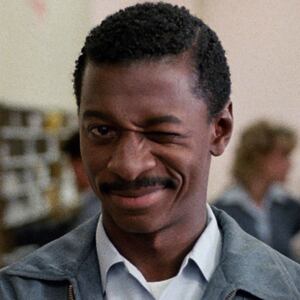It’s been 27 years since Cheryl Dunye released her first full-length feature, The Watermelon Woman, an incisive and side-splitting comedy about Black film history, queer friendship, interracial relationships, and so much more.
Like many younger people—the film is as old as I am—I discovered Dunye’s film (or “Dunyementary,” as she calls it) through Letterboxd entries and streaming websites like Kanopy and Criterion Channel years after its debut at the 1996 Berlin International Film Festival. Despite an initially warm reception (aside from some predictable conservative backlash) and screenings at a handful of subsequent festivals, distributors weren’t too enthusiastic about The Watermelon Woman. The film was ultimately released by the small distribution company First Run Features in 1997, but like many 20th-century independent Black films, it became a hidden, underappreciated gem.
Thanks to Film Twitter, continued screenings, and other art forums in the intervening years, however, The Watermelon Woman has come to be heralded as a seminal piece of Black, queer cinema. Over the past five years, the film was acquired by the Museum of Modern Art and preserved by the National Film Registry. And now, fans of the cult classic can purchase a special edition, director-approved Criterion Blu-Ray.
ADVERTISEMENT

For Dunye, The Watermelon Woman’s new Criterion re-release isn’t just an opportunity to commemorate her most notable film, but to create a permanent archive of her previous works that have similarly fallen under the radar. In addition to new interviews with Dunye and other filmmakers and critics, the Blu-Ray disc includes six of her early shorts, including the great 1993 film The Potluck and the Passion, a hilarious dissection of sexual and racial politics taking place at a dinner party.
“It’s that point in my life where I’m trying to make that archive for the next generation,” Dunye told The Daily Beast. “There’s other kinds of queer Black filmmakers making work now. How can I help them?”
In fact, the value of art preservation is one of the many undercurrents in The Watermelon Woman’s intricate narrative. In the movie, Dunye plays a 25-year-old fictionalized version of herself named Cheryl, an avid film buff working at a video store with her best friend Tamara (Valarie Walker) in Philadelphia. A viewing of a (fictional) 1930s movie called Plantation Memories inspires Cheryl to make a documentary about the mysterious identity of the film’s stunning Black actress, who plays a “Mammy” archetype and is listed in the credits solely as “The Watermelon Woman.” (Both the offensive misnomer and the movie title are references to Melvin Van Peebles’ trailblazing 1970 film Watermelon Man, about a racist white man who wakes up in a Black man’s body.)
During her impromptu investigation, Cheryl falls for a white video store patron named Diana (Guinevere Turner), much to Tamara’s skepticism. While Cheryl initially ignores Tamara’s disapproval, she soon discovers that her attraction to Diana comes with some complications; Diana proves to be generally aloof and slowly demonstrates a fetishtic affinity for Black people. (Dunye explores similar territory in her 1990 short Janine.) Ultimately, however, Cheryl’s invigorating search for “the Watermelon Woman” allows her to engage with some tough questions about her own identity, desires, and relationship to the historically anti-Black medium of film.

With all of its fascinating dimensions and intertwining ideas, The Watermelon Woman could be described as a meta-meta—maybe add another meta—comedy. But it never feels belabored in its commentary, offering a hysterical, curious, and ultimately romantic look at Black, queer life instead.
On the occasion of The Watermelon Woman joining the Criterion collection, Dunye spoke with The Daily Beast about the film’s legacy, her television directing career (on shows like The Equalizer, Bridgerton, and The Umbrella Academy), and being name-dropped in the hit series Yellowjackets.
You’d done interviews with Criterion before, and they’ve previously streamed your film on the website. How did this opportunity finally come about?
When I had all my shorts back in the aughts, I was like, wow, I want to put all my shorts out there. And I wished they could look like a Criterion box because they’re so important. I love Criterion. So that was one bump. And that was my favorite streamer. So that was the second bump. And then third, it was time to move on from the distributor that we were working with for so many years. And Criterion was right on at that moment. It felt like a great place to put everything. You want to create an archive for your work to exist and reach a different kind of audience. And I love that family.
Has it previously been a struggle trying to find a place for your shorts?
Yeah, definitely. You think of these queer, Black, woman independent filmmakers who made lots of important films in the ’80s and ’90s—people don’t recognize people’s work. Nobody cares about them. It’s like a life that they had and they moved on. So you have to take care of yourself. So yeah, it was hard to find somebody to take them all at once. I think they were all over the place at one point, and I needed somebody to understand what having one body of work together means.
Is there a memory that sticks out to you about The Watermelon Woman’s initial release?
I remember a funny, controversial moment. I don’t remember what city it was—it was a “chocolate city,” like Baltimore, Detroit, or Chicago—and there were more Black women in the audience than had ever been there. The first question [I was asked] was, “This is not a Black lesbian film. There’s a white woman. Can you talk about that?” But I made it. I’m the Black lesbian. And it turned into a whole conversation about what that is. There was an understanding that if you’re going to make a Black lesbian film, there had to be all Black people. You can’t talk about those outside relationships. And then there was a whole other conversation about, am I a Black filmmaker? Am I a Black lesbian filmmaker? Am I just a filmmaker? We could talk about all that in cinema.
Are there any things you’d change about the movie?
There’s a few ADR bumps. We had an ADR-in-a-closet type of thing at that point, not a proper station to do it. So you hear some of the technical things. But generally, when I screen the film, I [think] of my mom. My mom passed away in 2004. I can always have a little visit with her and see my mom hamming it up and the relationship that we had and how I made her play herself.

How did documentaries become a template for your movies?
Just understanding Black history and Black cinema. There’s a few other documentaries about the Black movie industry I had seen. There’s one Ossie Davis does the voiceover for. I just love them. I’m all in for a good documentary that pieces that together well, or one that just uses something that I’ve never seen. And it’s authenticated when I got to the library and saw the books because there was no internet at that point. There’s a certain sense of, “Wow. What’s that book next to it? Blaxploitation? I’m going to get every book about Black film history here. Let me go to this other section, the queer section.” That led me to want to make that style of the film, that discovery and the effect that it had on me.
What’s it been like making a shift to television?
It’s a completely different muscle. There’s a team. I’m shooting to make my edit, but I’m also shooting so the studio can make their edit. I’m shooting with producers sitting behind me or sitting at some sort of monitor. So it’s not my film. My line is, “It’s above my pay grade.” But I do it. I know when it ends, I’m finished. I deliver it. I did a damn good job. I did all my research for it. And I tuck it away, and it’s gone. So the completion process of episodic television, that rhythm of living, feels great. The finances are the greatest I’ve ever probably had in my life because I’ve had the rice-and-beans life as an independent artist.
But the work of a narrative director of feature films of your own making, of your own finding—not the ones that the studio gives you—took seven years of my life. That’s a toll. I’m actually doing work on that right now because I’m about to jump onboard a project that I brought to a studio. They liked it and bought the option from me. And now I’m going to co-write and direct a film about a Black lesbian poet.
Are there any artists working now or media where you can spot your influence?
She’s also included in this re-release, but Martine Syms—being a talking head, playing with it, being a grad student questioning this process. I see [the film] growing and generationally being used in a kind of great way. The biggest one—I did like how they used it recently, and people were sending it to me, but of course they had to get the rights from me—was Yellowjackets Season 2, Episode 3 or 4. The red-haired character has a video store. And when another character is walking up, she’s talking to somebody about The Watermelon Woman and she said, “This is a great film.”







